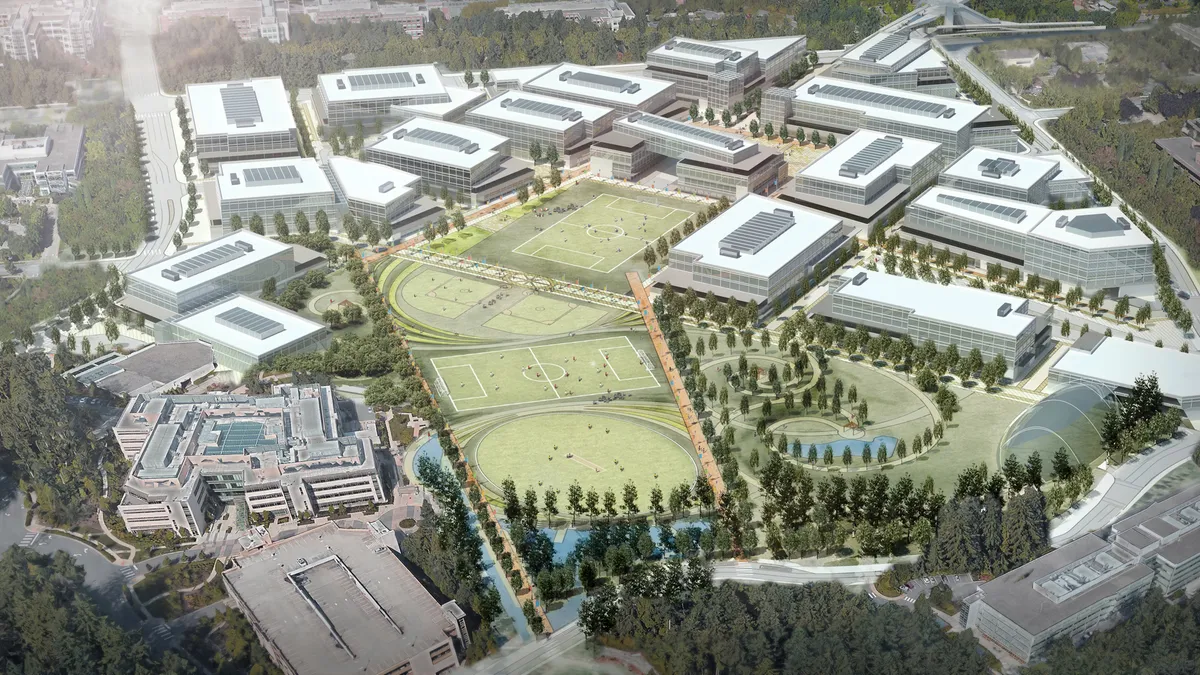Microsoft recently issued an update on the progress of its multibillion-dollar campus revitalization and modernization project in Redmond, Washington, and, as one would expect of the computing software giant, construction work is progressing with a little help from some of the most high-tech tools available. Namely, an eye in the sky— drone technology.
It's been more than 30 years since Microsoft settled on the Seattle suburb as its corporate office home, so the buildings and grounds are long due for a facelift, but the company is not just aiming for aesthetics. In its pursuit of a functional yet "healthy and inspiring" workplace for its employees, Microsoft will:
- Construct 17 new buildings, all between 180,000 square feet and 220,000 square feet, which will be split into four villages.
- Include accessibility features throughout the campus.
- Add atriums and courtyards to bring in daylight and to provide employees with outdoor access
- Align with local ecology in its quest for sustainability.
- Build a pedestrian bridge and new light-rail station .
- Make the campus mostly vehicle-free, with the exception of the development's periphery and underground parking.
The company has been underway with a 7-million-square-foot program of renovations, and, according to The Seattle Times, will max out the 2.5 million square feet for new construction allotted to it by the city in 2006. The net increase in space will be 1.3 million square feet added on to its existing 10 million square feet.
As part of the deal with local officials, Microsoft will contribute $150 million to the city of Redmond and the Central Puget Sound Regional Transit Authority (Sound Transit) to help cover the costs of infrastructure upgrades.
Microsoft's redevelopment should be complete in 2023, about the same time Sound Transit is complete with its new Redmond station.
A look at the progress
So, what work has Microsoft completed thus far?
As of the company's Sept. 23 update, construction crews led by Skanska USA, Balfour Beatty, GLY Construction and Sellen Construction, have:
- Made significant headway with the demolition at the development's east campus — more than 1.7 million square feet. All of the concrete and 95% of total demolition is headed for recycling.
- Completed excavation for the underground parking garage.
- Installed 51,000 (more than 9.5 miles) feet of fiber optic cable.
And then there's the technology that is helping to capture it all. Drone provider Skycatch is recording all construction activity on the Redmond campus, feeding data into more than 100 building information models (BIM) that contain almost three million 3D building components.
Skycatch, said Will Pryor, the company’s manager of enterprise solutions, is an old hand at corporate tech campuses. Its first daily scans were of Apple's "spaceship" campus in Cupertino, California, in 2014, and Skycatch also counts Facebook and Google as customers. (Google is also an investor in Skycatch.)
Like their other big tech campus projects, Pryor said, Skycatch uses an autonomous drone accompanied by a pilot who monitors its activity. For the Microsoft project, weekly drone flights are scheduled on the weekends, when activity on the site is at its lowest level. The drone is equipped with a high-accuracy GPS and camera, giving Skycatch the ability to build a digital twin of site conditions.
"It's almost like a live Google Maps in 3D," he said. "You never have outdated imagery."
Before tools like Skycatch, he said, owners had to rely on analog methods to monitor outdoor progress — i.e. superintendents walking the job with clipboard checklists, waiting on amended paper drawings to see the project's design changes and surveyors relying 100% on ground markings to measure completed excavations.
"We're doing all that in a single pass," Pryor said.
In addition to owners relying on drone data for what Pryor refers to as "quantifiable accountability," or a true data-driven measure of progress, which is particularly helpful when evaluating pay applications and predicting project schedules, the four general contractors also use it to better manage their work and a tight timeline.
Perhaps most important, he said, using drone data helps to answer Microsoft's overriding question of how to turn a building into data. “That's where we fit in," Pryor said.













